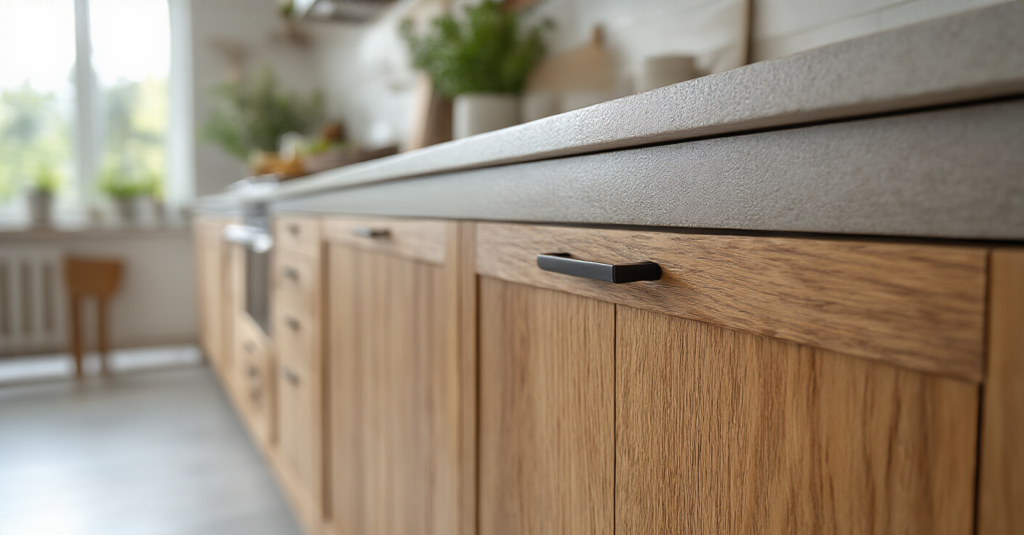I have to make a confession. I used to think creating a “natural” home was simple. You just bought things made of wood, right? Then I started helping my Polish grandmother clear out her attic, filled with old hand-carved furniture, and at the same time, was advising a client on their new apartment in Beijing, where the principles of Feng Shui and material harmony are deeply ingrained. It hit me. In both cultures, and so many others, “natural” was never just about the material itself. It was about respect for the entire story of an object—from the forest to the craftsman’s hands to the air it shared with your family for generations.
The modern idea of an “organic kitchen cabinet” gets lost in corporate-speak and “eco-luxury” marketing. Everyone’s selling a green-washed dream, but they rarely talk about what truly matters. It’s not about slapping a bamboo veneer on a box of toxic glue. It’s about building a kitchen that breathes. A space that is healthy, not just in the food it produces, but in its very bones. Forget the noise. Let’s talk about what makes a kitchen truly nourishing for the soul. This is about creating a space with integrity, one that tells your own cultural story.
Foundations: Understanding Your Organic Cabinet Choice
Before you even look at a single wood sample, you have to shift your perspective. This isn’t just about buying new cupboards. It’s about understanding the “why” behind your choices. We’re going to look past the marketing and get to the heart of what a healthy, sustainable cabinet really is, and why it’s one of the most profound investments you can make in your home and well-being.
1. Define “Organic Kitchen Cabinet”: Grasp True Eco-Friendly Building.
So what is an “organic kitchen cabinet,” really? Can we agree that it’s more of a philosophy than a product you can just pull off a shelf? It’s a promise. A promise that from the forest where the tree grew to the adhesive holding it together, every step was taken with respect for the planet and for your health. Forget the vague ‘green’ label. An authentically organic cabinet is one where the air inside your home is measurably cleaner because of it.

The real goal here is radical transparency. You should be able to ask your cabinet maker for the life story of your kitchen. Where did the wood come from? What’s in the glue? What’s in the finish? A reputable maker won’t flinch. A company hiding behind vague “eco” claims will. The biggest shortcut I can give you is this: if a manufacturer can’t provide a complete materials declaration, they are not truly “organic.” It’s like a restaurant that won’t tell you the ingredients in your food. Red flag.
Now, let’s explore why this deep dive into materials directly impacts the air you and your family breathe every day.
2. Health Benefits Unveiled: Breathe Easier with Non-Toxic Materials.
You know what people always ask me? “Will these cabinets really make a difference to my health?” My answer is always an emphatic yes. Think about it: your kitchen is the heart of your home, a place of nourishment. But conventional cabinets, made with cheap particleboard and harsh chemical finishes, spend years silently releasing toxins like formaldehyde into the air. It’s a contradiction we’ve been conditioned to accept.
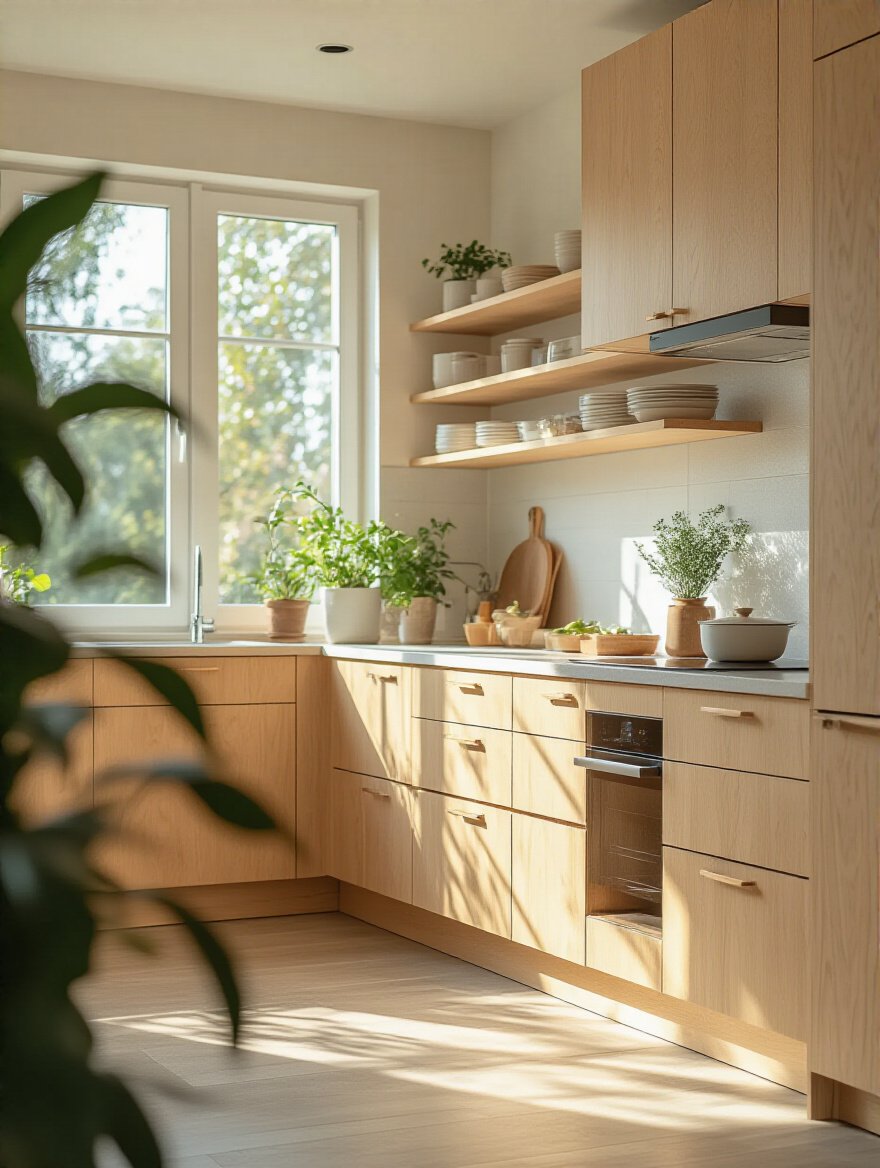
I once worked with a family whose young son had persistent allergies. They ate clean, used natural products, but he was always sniffling. We traced it back to their brand-new, standard-issue kitchen. Once we swapped the cabinets for solid wood boxes with zero-VOC finishes, his symptoms improved within months. This isn’t just noise; it’s about creating a space that actively supports your well-being, not one you have to recover from. Your home should be your sanctuary. The air you breathe in it is just as important as the food you eat.
With that in mind, let’s talk about how this personal health benefit extends to the health of the planet.
3. Sustainable Impact: Reduce Your Footprint with Responsibly Sourced Wood.
Everyone talks about “sustainability,” but the word has become almost meaningless. Here’s what it means to me, drawing from both my Polish and Chinese roots: stewardship. It means we are temporary caretakers of our resources, with a duty to leave things better than we found them. Choosing responsibly sourced wood for your cabinets is a powerful way to honor this. It’s a vote against illegal logging and for healthy, thriving forests that support entire ecosystems.

The shortcut here is to look for the Forest Stewardship Council (FSC) certification. This isn’t just a marketing gimmick; it’s a rigorous chain-of-custody system that tracks the wood from the forest floor all the way to your kitchen. It ensures that the forest is managed in a way that protects biodiversity and the local communities who depend on it. It’s the difference between buying an anonymous piece of timber and choosing one with a known, respectable family tree.
Making a choice with this kind of integrity doesn’t just feel good; it’s also a surprisingly smart financial move.
4. Long-Term Value: Why Investing in Eco-Cabinets Delivers ROI.
Can we talk about why everyone gets Return on Investment (ROI) wrong when it comes to kitchens? They focus on fast-fashion trends and cheap materials that might look good for a few years but are destined for a landfill. I call true value “Return on Integrity.” It’s the Polish farmer’s ethos: buy it once, buy it right, and make it last for generations. Well-made, non-toxic cabinets are not an expense; they are an asset.
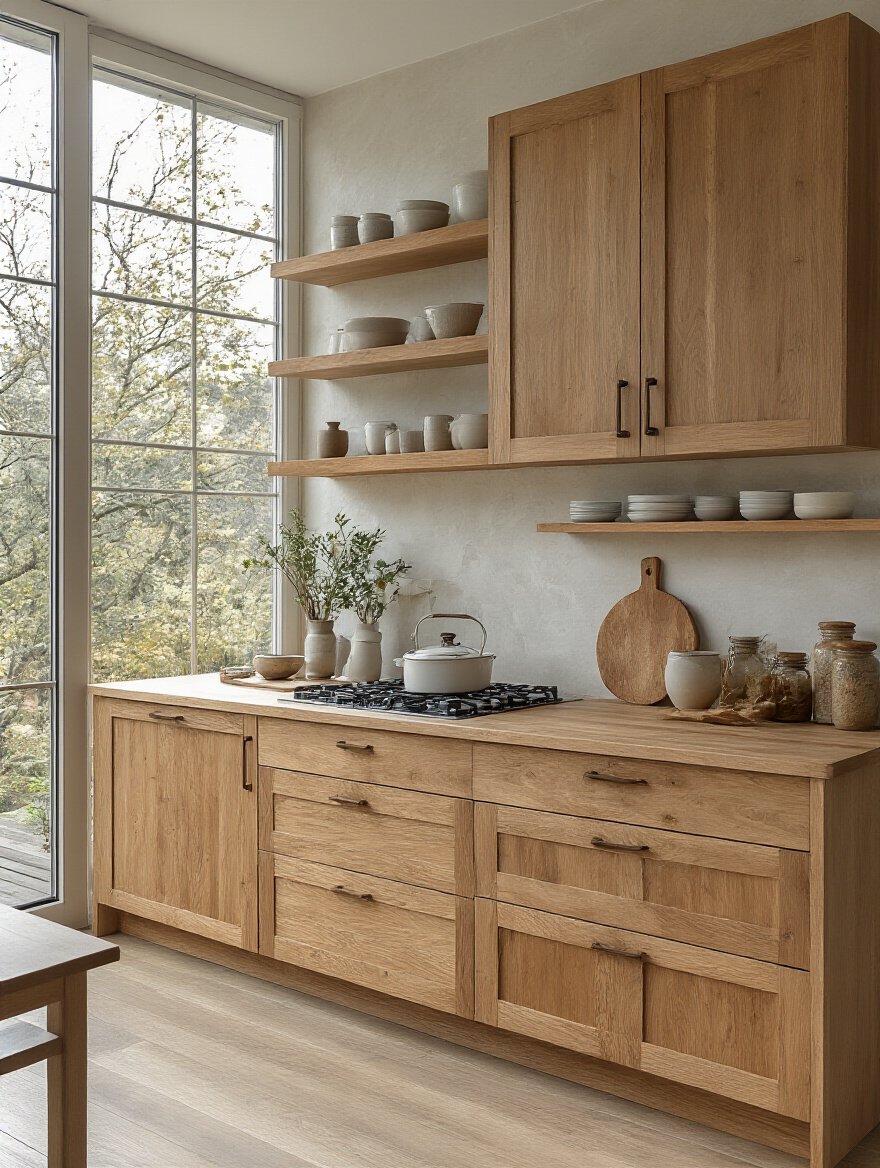
I’ve watched clients tear out 10-year-old kitchens made of MDF because the doors were peeling and the boxes were swelling. That’s not a good investment. A truly “organic” kitchen, built from solid wood with durable, non-toxic finishes, might have a higher upfront cost, but its lifespan can be 30, 40, even 50 years. When you factor in the health benefits and the sheer durability, the “cheaper” option is almost always the more expensive one in the long run. Don’t think of it as spending more; think of it as investing wisely.
Part of that investment is knowing what you’re protecting your family from, so let’s get specific about the invisible villains.
5. Identify Harmful VOCs: Avoid Hidden Toxins in Conventional Finishes.
Let’s imagine you’re hosting a beautiful dinner party. The food is exquisite, the company is warm, but there’s an invisible, unwelcome guest at the table making everyone feel a little dizzy and headachy. Those are Volatile Organic Compounds (VOCs). They’re chemical gases released from paints, glues, and finishes, and they are everywhere in conventional cabinetry. That “new kitchen smell” isn’t a sign of freshness; it’s the smell of off-gassing chemicals.
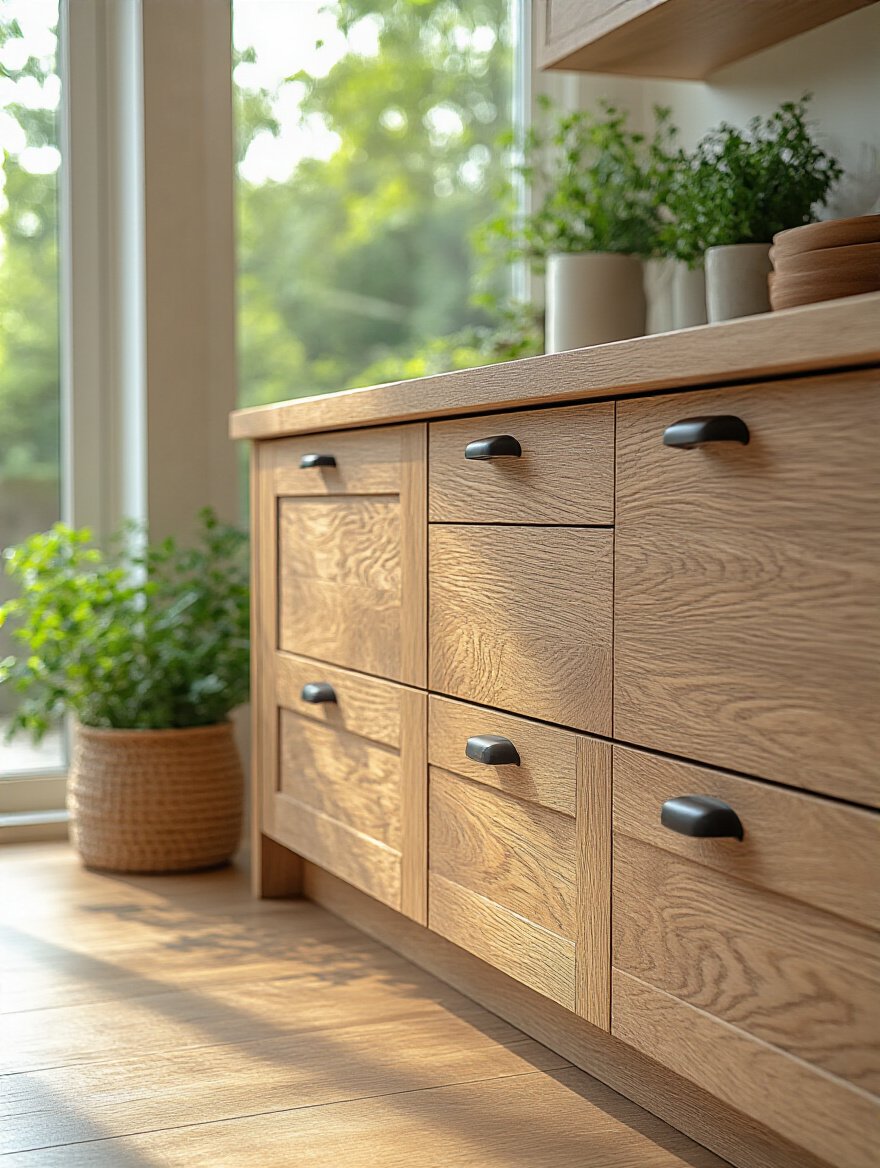
The real story here is that these chemicals don’t just go away after a few weeks. They can continue to pollute your indoor air for years, contributing to everything from asthma to more serious long-term health issues. The most common culprit is formaldehyde, used in the glues that bind composite woods like particleboard and MDF. Avoiding it is one of the single most important things you can do for your family’s health. Think of it as choosing building materials with the same care you’d use to choose ingredients for a meal.
Knowing this, how do you plan for the cost of choosing healthier options?
6. Budgeting for Eco-Luxury: Set Realistic Costs for Sustainable Options.
The term “eco-luxury” can sound intimidating, but it doesn’t have to be. It’s not about gold-plated fixtures; it’s about the luxury of clean air, peace of mind, and materials with integrity. Yes, authentically sustainable cabinets often have a higher upfront cost—typically 15-30% more than standard-issue boxes. Setting a realistic budget from the start is about honesty and priorities, not deprivation.
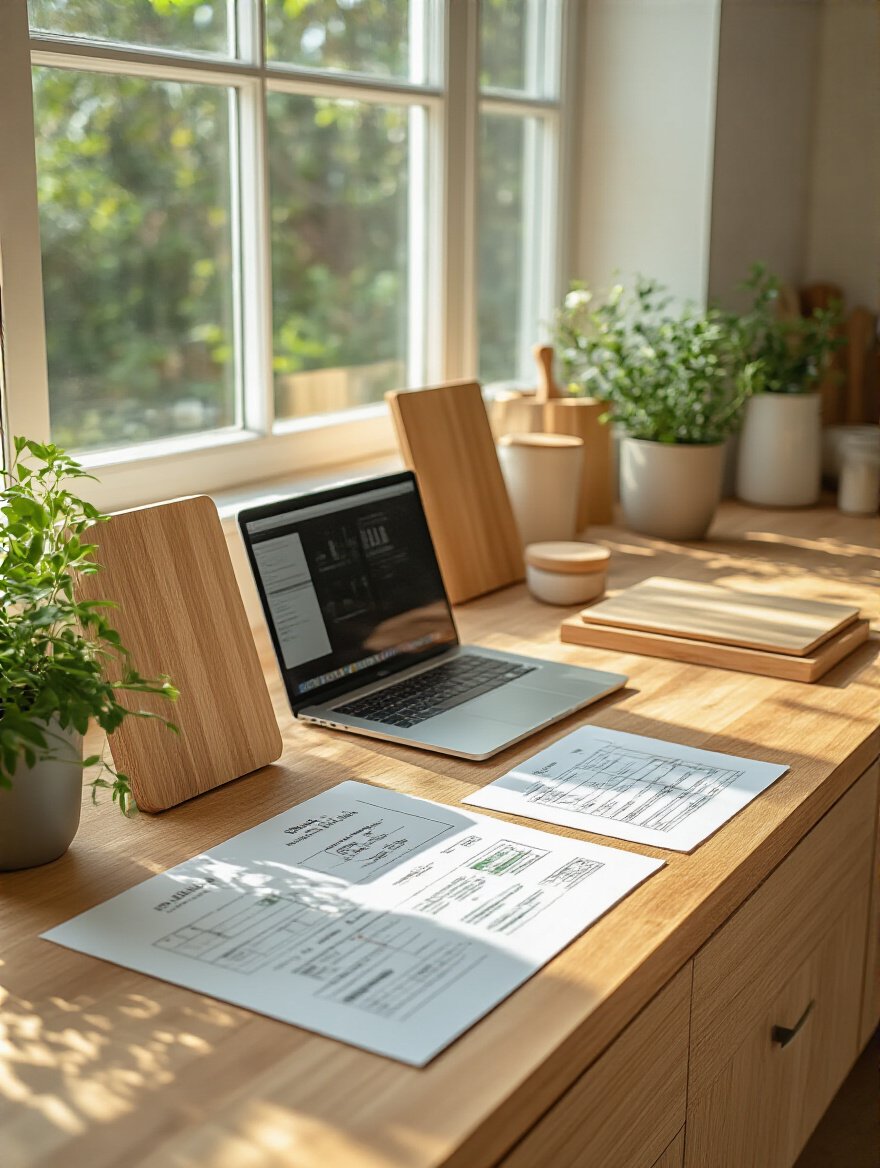
Here’s the shortcut I wish I’d known earlier: focus your budget on the “bones” of the kitchen. Spend the money on solid, formaldehyde-free cabinet boxes (the carcasses) and high-quality, non-toxic finishes. Those are the elements that impact your health and the longevity of your kitchen the most. You can always save money on things like hardware or even certain door styles, which can be upgraded later. A client of mine with a tight budget opted for simple, unfinished FSC-certified wood cabinets and painted them herself with a zero-VOC paint. She got the healthy foundation she wanted and saved thousands.
Now that we have the financial framework, let’s get into the specifics of choosing your materials.
Selection & Sourcing: Choosing Authentic Green Materials
This is where your vision starts to take physical form. It’s also where you can easily get fooled by “greenwashing.” Sourcing authentic materials is like being a cultural ambassador in your own home—you have to look beyond the surface and understand the true story of each element. This section is your field guide to making choices with integrity.
7. Explore Certified Wood Species: Select Responsibly Managed Hardwoods for Durability.
Wood is not just wood. Every piece has an origin, a story. A certified hardwood, like one with the FSC label, has a story you can be proud of. It means the forest it came from is treated as a living system, not a resource to be stripped bare. This ensures the health of the forest and the quality of the wood itself. When you choose a certified hardwood like oak, maple, or cherry, you’re choosing durability.

These woods have a density and stability that you just don’t find in the fast-grown, mystery-source timber used in so much mass-produced furniture. My Polish grandmother’s oak table has withstood a century of hot dishes, spilled wine, and family arguments. That’s the kind of resilience you’re investing in. Think of it as choosing an ingredient for its provenance and its character. Don’t just ask “what species is it?”; ask “where did it live and who looked after it?”
Beyond the solid wood, the construction of the cabinet box is where most manufacturers cut corners. Here’s what to look for.
8. Understand NAUF Plywood: Demand No Added Urea Formaldehyde Cores.
Here’s where things get technical, but it’s probably the most important point in this entire guide. Most cabinet boxes, even in expensive kitchens, are made from plywood or particleboard. The problem is the glue holding the wood fibers together, which is traditionally full of urea-formaldehyde. Demanding NAUF plywood—which stands for “No Added Urea Formaldehyde”—is non-negotiable for a healthy kitchen.

Think of it this way: the door front is the pretty face, but the cabinet box is the lungs. If the box is toxic, the whole system is toxic. Some companies will try to sell you on “low-formaldehyde” options, but why accept a little bit of poison? Go for NAUF (good) or NAF (No Added Formaldehyde—even better). This is the single biggest place where manufacturers hide toxins to save a few dollars. Don’t let them. Make it a deal-breaker.
Once the core is healthy, you need to ensure the “skin” is, too. Let’s talk finishes.
9. Choose Water-Based Finishes: Minimize VOCs for Superior Air Quality.
The finish on your cabinets is what you touch every day. It’s the final barrier between you and the wood, and it has a huge impact on your air quality. Traditional solvent-based lacquers and varnishes are loaded with VOCs that off-gas for years. Modern, high-quality water-based finishes have come a long way. They are durable, beautiful, and won’t poison your air.

The key is to look for finishes that are labeled “zero-VOC” or “low-VOC.” And I mean truly low, under 50 grams per liter. Many cabinet makers now use incredibly tough, water-based polyurethane finishes that are just as resilient as their toxic predecessors. It’s about demanding modern chemistry that works for us, not against us. I always say the finish should protect the wood, not require you to protect yourself from the finish.
Now for the last piece of the invisible puzzle: the glue.
10. Prioritize Non-Toxic Glues: Ensure Adhesive Safety for Interior Health.
If the cabinet box is the lungs and the finish is the skin, then the glue is the connective tissue. It’s what holds everything together, and it’s another major source of hidden toxins. When you are specifying your cabinets, you need to ask not only about the plywood core but about the adhesives used in the assembly process itself.

A truly committed “organic” cabinet maker will be using non-toxic, water-based glues like a PVA (Polyvinyl Acetate) adhesive for assembly. The BS everyone else says is that this detail doesn’t matter, that it’s a tiny amount of glue. But it all adds up. I helped a family design a nursery once, and we specified every single material down to the glue. The peace of mind that comes from knowing you’ve eliminated every possible source of toxins is immeasurable. Don’t overlook the glue.
All these technical terms can be confusing. That’s why certifications are your best friend.
11. Decipher Eco-Certifications: Look for FSC, GreenGuard, and LEED Compliance.
In a marketplace full of confusing claims, third-party certifications are your trusted guides. They cut through the noise and give you a simple, verifiable seal of approval. Think of them as passports for your materials, proving they are what they claim to be. You don’t need to be an expert in forestry or chemistry if you know which labels to look for.

Here’s your shortcut list. Memorize it.
- FSC (Forest Stewardship Council): For wood. This means it comes from a responsibly managed forest.
- GreenGuard Gold: For finishes, adhesives, and composite wood. This is your gold standard for low chemical emissions and clean air. It’s stricter than regular GreenGuard and designed for sensitive environments like schools and healthcare facilities—and your kitchen.
- LEED (Leadership in Energy and Environmental Design): This is a whole-building standard, but choosing materials that contribute to LEED points is a good sign a manufacturer is serious about sustainability.
A client once showed me a brochure for “eco-cabinets” that had no certifications. When we pushed the supplier, it turned out their claim was based solely on using bamboo doors. The boxes were toxic MDF. Certifications protect you from that kind of deception.
Let’s also talk about an often overlooked material with a powerful story.
12. Recycled Content Advantages: Integrate Upcycled Materials for Green Design.
There is a profound beauty in giving materials a second life. In both my Polish and Chinese cultures, resourcefulness is a virtue. Nothing goes to waste. Integrating recycled or upcycled materials into your kitchen is a way to honor this tradition. It’s not about making a “junkyard” kitchen; it’s about choosing materials with soul and character.

This could mean cabinet fronts made from reclaimed barn wood, which tells a story of a hundred seasons. It could be countertops made from recycled glass and concrete, or hardware forged from recycled brass. The advantage isn’t just environmental; it’s aesthetic. You get a patina and a depth of character that you simply cannot replicate with brand-new materials. It turns your kitchen from a sterile new space into one that feels like it has always been a part of your home’s story.
With your materials chosen, it’s time to bring them together into a beautiful and functional design.
Design & Installation: Creating Your Sustainable Kitchen Space
This is where the soul of your project takes shape. An organic kitchen isn’t just about healthy materials; it’s about a design that supports a healthy and harmonious life. It requires thoughtfulness in the layout and a partnership with a builder who understands and respects your vision. Every choice here, from cabinet placement to drawer pulls, is an opportunity to reinforce your commitment to quality.
13. Functional Layout Design: Maximize Storage with Healthy Cabinetry Solutions.
A beautiful kitchen that doesn’t function well is a failure. And a healthy kitchen that’s cluttered and disorganized won’t feel harmonious. Good design, whether you’re looking at it from a pragmatic European perspective or through the lens of Feng Shui, is about flow. It’s about creating a space where cooking is a pleasure, not a chore. This means thinking about the “work triangle”—the path between your sink, stove, and refrigerator—and designing storage that makes sense.

Instead of just filling walls with cabinets, think about function. Deep drawers for pots are far more ergonomic than deep base cabinets. A full-height pantry with pull-out shelves makes food storage visible and accessible. By designing smarter, not just bigger, you can often use fewer cabinets, saving resources and money. Good design is, by its very nature, sustainable because it uses space and materials with intelligence and purpose.
Once the layout is set, it’s time to infuse it with your personal story.
14. Personalize Cabinet Styles: Match Aesthetics with Your Eco-Friendly Vision.
Your home should be a reflection of your journey. As someone from a multicultural background, this is deeply important to me. This is your chance to blend different parts of your heritage or your travels into a cohesive whole. An eco-friendly vision doesn’t lock you into one “crunchy granola” aesthetic. You can be sleek and modern with FSC-certified bamboo, or warm and traditional with reclaimed oak Shaker doors.

The key is authenticity. I worked with a couple—he was Swedish, she was Japanese—who wanted to blend their cultures. We ended up with minimalist, flat-panel cabinets made from pale, FSC-certified maple (a nod to Scandinavia) and integrated a beautiful countertop of dark, rich recycled paperstone that echoed Japanese lacquerware. The result was a kitchen that was uniquely theirs. Don’t be afraid to mix and match, as long as the underlying commitment to healthy, sustainable materials is your guide.
Finding the right person to build this vision is perhaps the most critical step of all.
15. Partner with Green Builders: Select Contractors Experienced in Sustainable Installations.
Picture this: You’ve spent months researching, sourcing the perfect formaldehyde-free plywood and zero-VOC finishes. Then the installer shows up and glues everything together with a tube of toxic construction adhesive, wiping it all down with a chemical solvent. All your hard work and investment, undone in an afternoon. This happens more than you’d think.
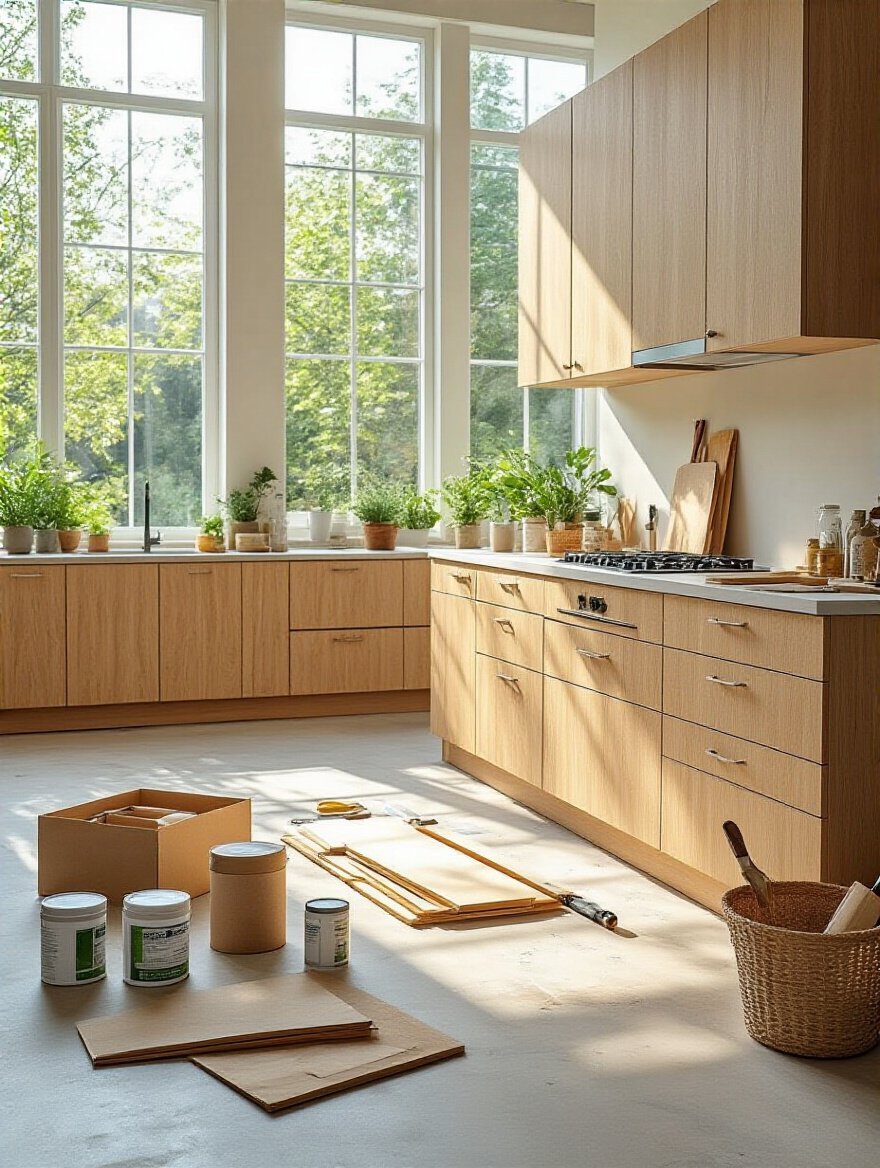
Partnering with a builder who specializes in or at least has experience with sustainable installation is not a luxury; it’s a necessity. These professionals understand the assignment. They know which caulks are non-toxic, how to minimize dust, and how to handle and install your beautiful materials with the respect they deserve. Ask potential contractors, “What specific low-VOC adhesives and sealants do you use?” If they can’t answer, they are not the right partner for your project.
During installation, there’s one element that’s critical for both your new cabinets and your health.
16. Ensure Proper Ventilation: Optimize Airflow During Cabinet Installation for Health.
Your kitchen needs to breathe. Solid wood cabinets, in particular, need stable humidity to prevent swelling, shrinking, and warping. But even more importantly, proper ventilation ensures a healthy environment for you. Even low- or zero-VOC materials can have a slight odor during installation, and good airflow helps dissipate it quickly.

This comes down to two things. First, make sure your kitchen design doesn’t block any HVAC vents. Second, and this is crucial, invest in a high-quality, properly-vented range hood. A range hood that just recirculates air through a charcoal filter is not ventilation. It’s an ornament. A hood that vents directly to the outside is the single best tool for removing cooking fumes, moisture, and any lingering indoor pollutants. It’s the lungs of your kitchen.
Now for the finishing touches—the parts you interact with every single day.
17. Specify Eco-Hardware: Choose Sustainable Pulls, Hinges, and Drawer Glides.
It’s easy to overlook hardware, but the pulls, hinges, and drawer glides are the jewelry of your kitchen. They are the tactile points of contact you engage with daily. Choosing them thoughtfully completes the story of your organic kitchen. Conventional hardware is often chrome-plated, a highly toxic process, or made from virgin metals with a huge carbon footprint.

Look for hardware made from recycled materials like brass, bronze, or Stainless Steel. There are incredible artisans who forge beautiful pulls from recycled metals. Or choose durable, high-quality hinges and drawer glides from reputable European brands known for their longevity. A well-made hinge can last for decades, reducing waste and the frustration of sagging cabinet doors. This is a small detail that makes a big difference in the overall integrity and feel of your kitchen.
Finally, let’s look at the surface that ties it all together.
18. Integrate Green Countertops: Complement Organic Cabinets with Healthy Surfaces.
Your countertops are your primary work surface. You prep food on them, your kids do homework on them, you lean on them while you drink your morning coffee. They need to be as healthy as the cabinets they sit on. Many conventional countertops, like laminate or even some engineered stones, use formaldehyde-based resins that can off-gas into your home.

There are so many beautiful, healthy alternatives. Natural stone like soapstone or quartzite, solid wood, recycled glass, or even PaperStone (a super-dense composite of recycled paper and non-toxic resin) are all fantastic choices. I had a client choose a countertop made of recycled porcelain and glass chips set in concrete. It was stunning, incredibly durable, and told a wonderful story about recycling. The key is to think about the entire lifecycle and choose a surface that complements your organic cabinets in both aesthetic and philosophy.
Once your beautiful, healthy kitchen is installed, you’ll want to protect it for the long haul.
Maintenance & Longevity: Preserving Your Organic Cabinetry
The most sustainable product is the one you don’t have to replace. Unlike the disposable kitchens of the last few decades, a well-built organic kitchen is designed to be cared for, repaired, and cherished for a lifetime. This final part of the journey is about stewardship—the simple, gentle practices that will ensure your investment remains beautiful for years to come.
19. Gentle Cleaning Techniques: Protect Cabinet Finishes with Natural Solutions.
Please, step away from the harsh chemical sprays. They are the enemy of your beautiful organic cabinets. Aggressive cleaners can strip natural oil finishes, dull water-based lacquers, and damage the wood itself. Protecting your investment means embracing a simpler, gentler way of cleaning, the way my grandmother cared for her furniture.

All you really need is a soft microfiber cloth and a simple solution of a few drops of mild, pH-neutral soap in warm water. For tougher grease, a little-diluted vinegar works wonders. The most important step? Dry the surface immediately with a clean, dry cloth. Water is the natural enemy of wood. A quick, gentle wipe-down is all it takes to keep your cabinets looking pristine without compromising their finish or your indoor air quality.
But what if an accident happens?
20. Simple Surface Repairs: Fix Minor Scratches and Dings Sustainably.
Life happens. A pot gets dropped, a toy gets thrown. On a cheap, laminate cabinet, a ding is a death sentence. But on a solid wood organic cabinet, a minor scratch or ding is just a moment in its life story—and one that can be easily healed. This is one of the greatest advantages of investing in quality materials.

For solid wood cabinets with an oil finish, you can often just lightly sand the area and re-apply a bit of the original oil. It blends in seamlessly. For painted or lacquered finishes, there are non-toxic wood fillers and touch-up kits. The key is to see these moments not as damage, but as opportunities for care. A home that is lived in will have imperfections. The ability to gracefully repair them is a hallmark of true quality.
This brings us to the final, and most important, principle.
21. Long-Term Protection: Safeguard Your Investment Against Everyday Wear.
Long-term protection is a mindset. It’s about cultivating an ongoing relationship of care with your kitchen. It’s not a list of chores, but a series of small, mindful habits that collectively preserve the beauty and function of your investment for decades. It’s the opposite of our modern disposable culture.

This means being mindful of humidity, wiping up spills promptly, and reapplying a protective coat of natural oil or wax to your cabinets every year or two, depending on the finish. Think of it as “feeding” the wood. A client of mine established a “Cabinet Spa Day” every autumn where they would gently clean and re-oil their beautiful walnut cabinets. It became a family ritual that taught their children about caring for their home. By embracing this philosophy, you ensure your kitchen doesn’t just last; it matures, developing a rich patina and character that can only come with time and care.
Conclusion
Creating a home with “organic” kitchen cabinets is about so much more than a design trend. It’s a return to a more profound, more thoughtful way of living. It’s a declaration that the health of our families and the health of our planet are not afterthoughts, but the very foundation of a beautiful life. By choosing materials with integrity, partnering with craftspeople who share your values, and embracing a mindset of long-term care, you are doing more than renovating a room. You are crafting a sanctuary.
You are building a space that tells your story, that honors heritage—whether it’s the Polish tradition of sturdy oak or the Chinese principle of living in harmony with nature—and that nourishes you on every level. The result is not just eco-luxury; it’s a home with a soul. A kitchen that truly breathes. And you deserve nothing less.
